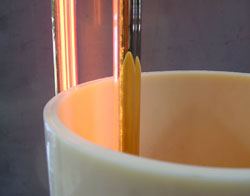Infrared Heat Forms Plastic Tubes Quickly and In A Targeted Fashion

Carbon Infrared emitters from Heraeus heat through thick PVC tubes in a few minutes. <br>Copyright Heraeus Noblelight 2008
• Infrared emitters heat plastics in a contact-free manner
• Optimally matched infrared emitters help to automate bending processes
• Infrared emitters from Heraeus Noblelight are on Stand 1121 in Hall B1 at Fakuma
Plastic tubes and pipes are increasingly being used in civil engineering as well as in domestic technology. Infrared emitters from Heraeus Noblelight help to stress relieve hoses, bend tubes and pipes or form sleeves. They transfer energy in a contact-free manner and generate heat primarily in the material. As a result, heating takes place uniformly and rapidly. This saves energy and space and the heating process can be easily automated.
Heraeus Noblelight is showing infrared heaters for plastics at Fakuma in Friedrichshafen from 14 to 18 October.
Tubes and pipes are used for wastewater, drainage, drinking water and gas or electric cable protection. Plastics such as Polyethylene (PE), polyvinylchloride (PVC) or polypropylene (PP) are increasingly replacing conventional materials such as concrete, stoneware and copper.
Before they are used, plastic tubes are bent into shape, provided with grooves for sealing rings or they have sleeves so that they can be inserted into each other. Conventionally hot air, heating sleeves or hot liquid baths have been used to soften the plastic before forming it. Infrared emitters transfer energy in a contact-free manner and generate heat primarily in the material. As a result heating takes place uniformly and no material sticks to the heat source. The targeted and controllable heat prevents thermal damage or messy pressure points.
Infrared emitters heat targeted areas of a tube or pipe, as the heated length of the emitter can be matched to the bending radius. In contrast to hot air oven, the edge areas remain relatively cool, which permits the component to be simply held, facilitating process automation. Infrared emitters can be precisely matched to the material and process and this saves energy. Because of the high heat transfer capacity of infrared radiation, heating times can also be reduced, which means production is faster or valuable production space is saved. Trials in our in-house Applications Centre have shown that a few minutes infrared radiation are sufficient to warm through PVC tubes with a wall thickness of more than 20 mm.
Conventionally, the sleeving of tubes takes place with the aid of heating jackets, which transfer heat into the plastic through close contact. Shortwave Omega emitters are circular and can heat small sections in a targeted manner. Omega emitters or small flat emitters arranged in a circle heat the tube ends without contact to make the plastic there soft, so that a sleeve socket can be formed.
Shortwave infrared emitters have response times in terms of seconds so that they can be easily controlled. They transfer heat rapidly at high efficiency. Infrared emitters need be switched on only when energy is needed and this is another energy-saving feature.
As well as shortwave emitters, Heraeus Noblelight also offers Carbon infrared emitters with a spectrum which is particularly well matched to the absorption characteristics of plastics. Carbon infrared emitters combine highly effective medium wave radiation with the short response times of shortwave emitters.
Common to all Heraeus emitters is the way they can be matched to the relevant process in terms of shape, size and spectrum. As a result, complex heating stages can be reproduced and automation can be introduced.
Heraeus Noblelight offers the complete spectrum of infrared heat from very shortwave NIR to medium wave Carbon Infrared (CIR). Heraeus has more than 40 years experience in infrared emitters and carries out practical tests with customers’ own materials in its own in-house Application Centres, to determine optimum process solutions.
Heraeus Noblelight GmbH with its headquarters in Hanau and with subsidiaries in the USA, Great Britain, France, China, Australia and Puerto Rico, is one of the technology- and market-leaders in the production of specialist light sources. In 2007, Heraeus Noblelight had an annual turnover of 90 Million € and employed 666 people worldwide. The organisation develops, manufactures and markets infrared and ultraviolet emitters for applications in industrial manufacture, environmental protection, medicine and cosmetics, research, development and analytical laboratories.
Heraeus, the precious metals and technology group headquartered in Hanau, Germany, is a global, private company with over 155 years of tradition. Our businesses include precious metals, sensors, dental and medical products, quartz glass, and specialty lighting sources. With product revenues of € 3 billion and precious metal trading revenues of € 9 billion, as well as over 11,000 employees in more than 100 companies worldwide, Heraeus holds a leading position in its global markets.
Further Information:
Readers:
Heraeus Noblelight GmbH
Reinhard-Heraeus-Ring 7
D-63801 Kleinostheim
phone +49 6181/35-8545, fax +49 6181/35-16 8545
E-Mail hng-infrared@heraeus.com
Press:
Dr. Marie-Luise Bopp
Heraeus Noblelight GmbH,
phone +49 6181/35-8547, fax +49 6181/35-16 8547
E-Mail marie-luise.bopp@heraeus.com
Media Contact
More Information:
http://www.heraeus-noblelight.comAll latest news from the category: Trade Fair News
Newest articles

First-of-its-kind study uses remote sensing to monitor plastic debris in rivers and lakes
Remote sensing creates a cost-effective solution to monitoring plastic pollution. A first-of-its-kind study from researchers at the University of Minnesota Twin Cities shows how remote sensing can help monitor and…

Laser-based artificial neuron mimics nerve cell functions at lightning speed
With a processing speed a billion times faster than nature, chip-based laser neuron could help advance AI tasks such as pattern recognition and sequence prediction. Researchers have developed a laser-based…

Optimising the processing of plastic waste
Just one look in the yellow bin reveals a colourful jumble of different types of plastic. However, the purer and more uniform plastic waste is, the easier it is to…



